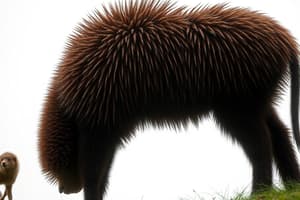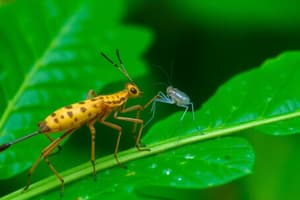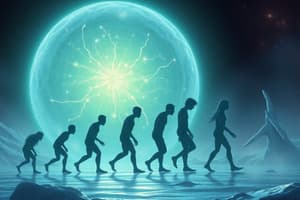Podcast
Questions and Answers
Which scenario would be LEAST applicable when using the biological species concept to classify organisms?
Which scenario would be LEAST applicable when using the biological species concept to classify organisms?
- Evaluating if fossils of ancient hominids belong to the same species as modern humans.
- Classifying bacterial species that reproduce asexually. (correct)
- Determining whether two groups of plants in the same geographic area are distinct species.
- Assessing if populations of birds on different islands are the same species.
Two species of frogs occasionally mate in the wild, but the resulting tadpoles never develop into mature frogs. This is an example of which type of reproductive isolation?
Two species of frogs occasionally mate in the wild, but the resulting tadpoles never develop into mature frogs. This is an example of which type of reproductive isolation?
- Hybrid infertility
- Temporal isolation
- Gametic incompatibility
- Hybrid inviability (correct)
A population of squirrels is geographically separated by a large river. Over time, the two squirrel populations diverge genetically. If the river dries up and the two populations can now interact, what would determine if speciation has occurred?
A population of squirrels is geographically separated by a large river. Over time, the two squirrel populations diverge genetically. If the river dries up and the two populations can now interact, what would determine if speciation has occurred?
- Whether the two populations exhibit similar physical characteristics.
- Whether the two populations interbreed and produce fertile offspring. (correct)
- Whether the two populations compete for the same resources.
- Whether the two populations occupy the same ecological niche.
Which of the following is a key distinction between allopatric and sympatric speciation?
Which of the following is a key distinction between allopatric and sympatric speciation?
Adaptive radiation is most likely to occur under which of the following conditions?
Adaptive radiation is most likely to occur under which of the following conditions?
Which of the following conditions was likely present on early Earth?
Which of the following conditions was likely present on early Earth?
The experiment that mimicked early Earth conditions was able to produce what?
The experiment that mimicked early Earth conditions was able to produce what?
Which of the following characteristics is unique to hominins compared to other primates?
Which of the following characteristics is unique to hominins compared to other primates?
Which of the following represents the correct order of taxonomic classifications, from broadest to most specific?
Which of the following represents the correct order of taxonomic classifications, from broadest to most specific?
Bacteria are characterized by all of the following EXCEPT:
Bacteria are characterized by all of the following EXCEPT:
Flashcards
Species Definition
Species Definition
A group whose members can potentially interbreed and produce fertile offspring.
Geographical Isolation
Geographical Isolation
Populations live in different places, preventing interbreeding.
Ecological Isolation
Ecological Isolation
Species occupy different habitats, limiting interaction.
Temporal Isolation
Temporal Isolation
Signup and view all the flashcards
Behavioral Isolation
Behavioral Isolation
Signup and view all the flashcards
Mechanical Incompatibility
Mechanical Incompatibility
Signup and view all the flashcards
Gametic Incompatibility
Gametic Incompatibility
Signup and view all the flashcards
Hybrid Inviability
Hybrid Inviability
Signup and view all the flashcards
Hybrid Infertility
Hybrid Infertility
Signup and view all the flashcards
Allopatric Speciation
Allopatric Speciation
Signup and view all the flashcards
Study Notes
- A species is currently defined as a group whose members can potentially interbreed and produce fertile offspring.
Limitations of the Biological Species Concept
- The concept relies on the ability to interbreed, making it unusable for species with asexual reproduction.
- Determining if extinct organisms could interbreed is impossible.
- Different species may mate in the wild and produce healthy, fertile offspring.
- Some organisms can breed in captivity but not in nature.
Reproductive Pre-Mating Isolation Mechanisms
- Geographical isolation occurs when populations live in different places.
- Ecological isolation occurs when species occupy different habitats.
- Temporal isolation occurs when species breed at different times.
- Behavioral isolation occurs when species have different mating rituals.
- Mechanical incompatibility occurs when species reproductive structures are incompatible.
Reproductive Post-Mating Isolation Mechanisms
- Gametic incompatibility happens when sperm from one species cannot fertilize eggs of another.
- Hybrid inviability occurs when hybrid offspring die early.
- Hybrid infertility occurs when hybrid offspring are sterile or have reduced fertility.
Speciation (Birth of a Species)
- Reproductive isolation of populations prevents gene flow.
- Genetic divergence of population must occur.
Pathways
- Allopatric speciation occurs when two populations become separated by a geographical barrier.
- Sympatric speciation occurs when an area contains two distinctly different habitats (ecological isolation).
- Adaptive radiation is the rise of many new species over a relatively short period, often when a species invades a variety of new habitats with few competitors.
Characteristics of Early Earth
- There was no atmosphere (no oxygen/ozone).
- There were extremely high UV rays.
- There were high amounts of methane/ammonia/water/hydrogen.
- There were many meteorite strikes and volcanic eruptions.
- Prebiotic simulation was used in the 1950s to mimic early Earth.
- Panspermia states that life originated elsewhere in the universe.
Modern Scientist Findings
- Scientists can produce amino acids, the building blocks of proteins, and potentially even protocells and ribozymes, when mimicking early Earth.
General Order of Organisms & Advantages of Each New Evolutionary Change
- Prokaryotes appeared first and then photosynthesis, oxygen, eukaryotes, multicellular organisms, plants on land, and animals on land (lobefin fish), amphibians, reptiles, and birds & mammals.
Primate Characteristics
- Grasping hands and feet, relatively large brains, and enhanced vision, including binocular vision are all features of primates.
- Lemurs, monkeys, apes, and humans are primates.
Hominin Characteristics
- Bipedalism, larger brains relative to body size, and the ability to make and use tools characterize hominins.
- Hominins also display behavioral and communication adaptations like specialized tool use and potential language.
Australopithecines Characteristics
-
Early characteristics include a mix of ape-like and human-like traits, including bipedal locomotion.
-
Retaining features like long arms and smaller brains suggests a transition from ape-like ancestors to humans.
-
Later characteristics include a mix of ape-like and human-like traits, including bipedalism and adaptations for both tree climbing and ground walking.
-
Homo erectus and Neanderthals migrated out of Africa, are extinct, and are not direct ancestors.
-
Homo sapiens are approximately 150,000 years old, based on genetic diversity across the globe.
Taxonomy
- Taxonomy is the branch of biology concerned with naming and classifying organisms.
- Naming is a two-part scientific name based on genus and species.
- A genus includes a number of very closely related species.
- A species contains organisms that can potentially interbreed.
Taxonomic Classifications
- Domain, Kingdom, Phylum, Class, Order, Family, Genus, and Species.
- The three domains of Eukarya include Eukaryota (chromists, plants, animals, fungi, alveolates, rhodophytes, flagellates, basal protists), Bacteria (cyanobacteria, heterotrophic bacteria), and Archaea (halophiles, thermophiles).
- The four groups of Eukarya include animals, plants, fungi, and protists.
- Phylogenetics studies the evolutionary relationships among species.
- Reading evolutionary trees is done irrespective of which side one puts a group on, since branches can be spun at the nodes, which represent speciation.
- Clades group all organisms that share a common ancestor.
Prokaryotes
- Prokaryotes are the smallest living thing and are single-celled.
- They have three common shapes: spherical, rod, and spiral.
- They reproduce by binary fission and undergo asexual cell division.
- Conjugation involves exchanging genetic material without reproducing with a sex pilus connecting donor to recipient
- Prokaryotes exchange plasmids, which are circular DNA.
- Rapid revolution occurs, explaining why antibiotic resistance occurs.
Bacteria & Archaea
- Archaea can produce methane, but bacteria can't.
- Bacteria can undergo photosynthesis, but archaea can't.
- Some bacteria are pathogenic, but archaea aren't.
- Bacteria contain peptidoglycan, but archaea don't.
- Gram + stains are purple.
- Gram - stains are red/pink and have a fatty layer.
- Some bacteria produce endospores or biofilms, but archaea don't.
- Biofilms are slime-secreting bacteria.
- Endospores are resistant to extremely harsh conditions.
Anthrax
- Plasmids make strains of Anthrax virulent via toxins/capsule.
- Modes of infection include inhalation, cutaneous, and gastrointestinal.
- Virulent factors are plasmids that code for Anthrax toxins and create a capsule.
Key Terms
- Heterotrophs absorb nutrients that surround them.
- Autotrophs self-feed through photosynthesis.
- Pathogens cause harm, disease, illness, and even death.
Prokaryotes & Other Organisms/Environment
- They have 4 positives: nutrition, recycling, nitrogen fixation, and bioremediation.
- They also have 1 negative: pathogenic qualities.
Viruses
- Viruses contain DNA or RNA and a protein coat.
- Viruses are not cells and are smaller than bacteria.
- Viruses cannot reproduce without a host, and they can attack all living organisms.
- Examples include SARS-COVI-2, Influenza, and Measles.
Viroids
- Characteristics include short, only RNA that affect crops only.
Prions
-
Characteristics include that they are only protein, have no genetic material, and are resistant to heat.
-
Bacteria are single-celled, microscopic, prokaryotic organisms with a cell wall containing peptidoglycan.
-
Viruses are acellular, obligate intracellular parasites, lacking cells and only replicate inside a host cell, consisting of a nucleic acid core (DNA or RNA) encased in a protein coat (capsid), and some have an outer envelope.
-
Prions are unique infectious agents composed solely of protein, lacking genetic material, and cause transmissible spongiform encephalopathies (TSEs), which are fatal and neurodegenerative diseases in both humans and animals.
Studying That Suits You
Use AI to generate personalized quizzes and flashcards to suit your learning preferences.




